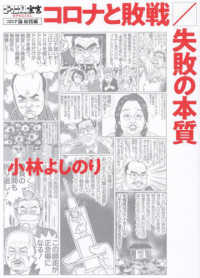- ホーム
- > 洋書
- > 英文書
- > Science / Mathematics
Full Description
Systematically presents the input-output finite-time stability (IO-FTS) analysis of dynamical systems, covering issues of analysis, design and robustness
The interest in finite-time control has continuously grown in the last fifteen years. This book systematically presents the input-output finite-time stability (IO-FTS) analysis of dynamical systems, with specific reference to linear time-varying systems and hybrid systems. It discusses analysis, design and robustness issues, and includes applications to real world engineering problems.
While classical FTS has an important theoretical significance, IO-FTS is a more practical concept, which is more suitable for real engineering applications, the goal of the research on this topic in the coming years.
Key features:
Includes applications to real world engineering problems.
Input-output finite-time stability (IO-FTS) is a practical concept, useful to study the behavior of a dynamical system within a finite interval of time.
Computationally tractable conditions are provided that render the technique applicable to time-invariant as well as time varying and impulsive (i.e. switching) systems.
The LMIs formulation allows mixing the IO-FTS approach with existing control techniques (e. g. H∞ control, optimal control, pole placement, etc.).
This book is essential reading for university researchers as well as post-graduate engineers practicing in the field of robust process control in research centers and industries. Topics dealt with in the book could also be taught at the level of advanced control courses for graduate students in the department of electrical and computer engineering, mechanical engineering, aeronautics and astronautics, and applied mathematics.
Contents
Preface xi
List of Acronyms xiii
1. Introduction 1
1.1 Finite-Time Stability (FTS) 1
1.2 Input-Output Finite-Time Stability 6
1.3 FTS and Finite-Time Convergence 10
1.4 Background 10
1.4.1 Vectors and signals 10
1.4.2 Impulsive dynamical linear systems 12
1.5 Book Organization 13
2. Linear Time-Varying Systems: IO-FTS Analysis 15
2.1 Problem Statement 15
2.2 IO-FTS for W2 Exogenous Inputs 16
2.2.1 Preliminaries 16
2.2.2 Necessary and sufficient conditions for IO-FTS for W2 exogenous inputs 22
2.2.3 Computational issues 25
2.3 A Sufficient Condition for IO-FTS for W∞ Inputs 26
2.4 Summary 29
3. Linear Time-Varying Systems: Design of IO Finite-Time Stabilizing Controllers 33
3.1 IO Finite-Time Stabilization via State Feedback 34
3.2 IO-Finite-Time Stabilization via Output Feedback 36
3.3 Summary 42
4. IO-FTS with Nonzero Initial Conditions 45
4.1 Preliminaries 45
4.2 Interpretation of the Norm of the Operator LSNZ 48
4.3 Sufficient Conditions for IO-FTS-NZIC 52
4.4 Design of IO Finite-Time Stabilizing Controllers NZIC 55
4.4.1 State feedback 56
4.4.2 Output feedback 57
4.5 Summary 58
5. IO-FTS with Constrained Control Inputs 61
5.1 Structured IO-FTS and Problem Statement 61
5.2 Structured IO-FTS Analysis 63
5.3 State Feedback Design 65
5.4 Design of an Active Suspension Control System Using Structured IO-FTS 67
5.5 Summary 70
6. Robustness Issues and the Mixed H∞/FTS Control Problem 71
6.1 Preliminaries 72
6.1.1 System setting 72
6.1.2 IO-FTS with an H∞ bound 73
6.2 Robust and Quadratic IO-FTS with an H∞ Bound 77
6.2.1 Main result 78
6.2.2 A numerical example 80
6.3 State Feedback Design 82
6.3.1 Numerical example: Cont'd 85
6.4 Case study: Quadratic IO-FTS with an H∞ Bound of the Inverted Pendulum 86
6.5 Summary 88
7. Impulsive Dynamical Linear Systems: IO-FTS Analysis 89
7.1 Background 90
7.1.1 Preliminary results for the W2 case 90
7.2 Main Results: Necessary and Sufficient Conditions for IO-FTS in Presence of W2 Signals 91
7.3 Example and Computational Issues 96
7.4 Main Result: A Sufficient Condition for IO-FTS in Presence of W∞ Signals 98
7.4.1 An illustrative example 99
7.5 Summary 100
8. Impulsive Dynamical Linear Systems: IO Finite-Time Stabilization via Dynamical Controllers 103
8.1 Problem Statement 103
8.2 IO Finite-Time Stabilization of IDLSs: W2 Signals 104
8.2.1 A numerical example 107
8.3 IO Finite-Time Stabilization of IDLSs: W∞ Signals 108
8.3.1 Illustrative example: Cont'd 110
8.4 Summary 111
9. Impulsive Dynamical Linear Systems with Uncertain Resetting Times 113
9.1 Arbitrary Switching 113
9.2 Uncertain Switching 114
9.3 Numerical Example 116
9.3.1 Known resetting times 117
9.3.2 Arbitrary switching 118
9.3.3 Uncertain switching 118
9.4 Summary 119
10. Hybrid Architecture for Deployment of Finite-Time Control Systems 121
10.1 Controller Architecture 121
10.2 Examples 123
10.2.1 Hybrid active suspension control 123
10.2.2 Lateral collision avoidance system 124
10.3 Summary 129
A. Fundamentals on Linear Time-Varying Systems 131
B. Schur Complements 137
C. Computation of Feasible Solutions to Optimizations Problems
Involving DLMIs 139 D. Solving Optimization Problems Involving DLMIs using MATLAB® 145
E. Examples of Applications of IO-FTS Control Design to Real-World Systems 151
References 159
Index 167








